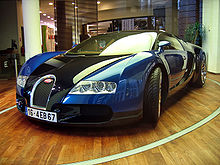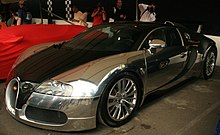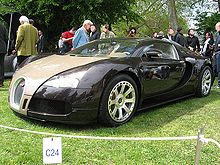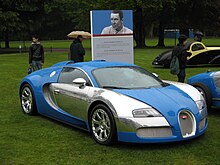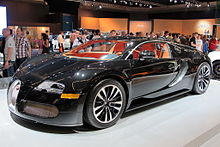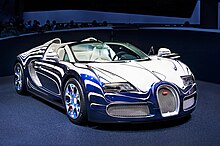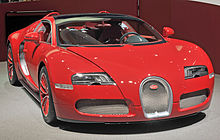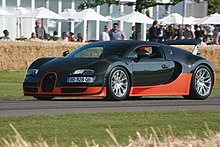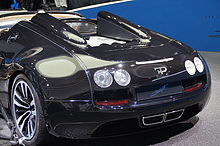Bugatti Veyron 16.4
| Bugatti | |
|---|---|
| Veyron April 16 | |
| Production period: | 2005-2015 |
| Class : | Sports car |
| Body versions : | Coupe |
| Engines: |
Petrol engines : 8.0 liters (736-883 kW) |
| Length: | 4462 mm |
| Width: | 1998 mm |
| Height: | 1204 mm |
| Wheelbase : | 2710 mm |
| Empty weight : | 1888 kg |
| successor | Bugatti Chiron |
The Bugatti Veyron 16.4 is a French super sports car from Bugatti Automobiles , which was developed by the Volkswagen Group under the brand name Bugatti . Several speed records were broken with him.
background
particularities
In the Bugatti Veyron 16.4 Super Sport model variant (since 2010), the vehicle combines a number of superlatives and special features. These include the eponymous 16 cylinders of the 530 kg mid-engine (640 kg with gearbox), the arrangement of the cylinders in V-VR shape (not a real W-engine ), the 110 kg seven-speed gearbox with double clutch , the maximum power of 883 kW (1200 PS), the top speed of 431 km / h, the four turbochargers , a total of ten coolers, the maximum consumption of up to 100 liters per 100 km, the maximum torque of 1500 Nm and the acceleration from 0 to 100 km / h in 2.5 seconds. By telemetry data of the vehicle at Bugatti's headquarters are available.
In order to be able to brake the heavy vehicle safely, carbon-ceramic brake discs are installed, which bring the vehicle to a stop from 100 km / h in 2.3 seconds over a distance of 31.4 m. As with the Mercedes-Benz SLR McLaren , the rear wing is automatically set steeper at speeds above 240 km / h from a brake pedal time of 0.4 s , which reduces lift or increases the car's downforce.
prehistory
In May 1998, the Volkswagen Group acquired the trademark rights to the former automobile manufacturer Bugatti . In October of the same year, the first concept vehicle to revive the brand was presented, the four-seater Coupe EB 118 . The EB 218 studies followed in 1999 , a four-door sedan and the EB 18/3 Chiron mid-engine sports car. The idea of a four-door sedan was picked up for the 16C Galibier in 2009 , but was not realized, while the successor to the Veyron was named Chiron . All three studies still had the originally intended 18-cylinder W engine with three cylinder banks before this concept was discarded due to technical problems.
The Veyron study was finally presented at the Tokyo Motor Show in 1999, but at that time it was still under the name “Bugatti Veyron EB 18.4”. Outwardly, this came close to the later production model, but was still equipped with an 18-cylinder engine.
The Volkswagen Group made the decision to go into series production in 2001. The first ready-to-drive prototype was completed in August 2003. Except for a few details, it is similar to the later production model. In the development to series production, however, considerable technical problems had to be solved, so that the start of production was repeatedly postponed and was delayed until September 2005.
Naming
The name of the super sports car comes from the French racing driver Pierre Veyron , who was active between 1933 and 1953. He was hired by Ettore Bugatti's son in 1932. Veyron became a test driver, development engineer and from then on successfully optimized Bugatti's racing cars. The suffix 16.4 indicates the number of cylinders and the exhaust gas turbocharger.
technology
Design / aerodynamics
The design of the vehicle was in 1999 by the then Volkswagen design chief Hartmut Warkuß in collaboration with the then only 26-year-old young designers Jozef Kabaň - who later became head of exterior design of Audi , interim Head of Design at Škoda , later BMW and now a chief designer at Rolls-Royce - developed and supervised until the end of series production. The design of the car led to problems in the technical implementation: The rather round shape of the body created aerodynamic disadvantages because it is not optimal for the planned maximum speed of over 400 km / h. The drag coefficient (c w ) of the Veyron is relatively high for a sports car and is 0.393 in the normal configuration between that of a VW New Beetle (0.38) and a VW Golf I (0.41).
In the produced version, a hydraulically extendable rear wing helps to stabilize the car at high speeds. This increases the air resistance, which means that more than the planned 736 kW would actually be necessary to achieve the projected speed. This problem was solved by the introduction of the so-called "speed key": in the normal setting the car reaches 375 km / h, with the speed key (a kind of second ignition key to the left of the driver's seat) the car is lowered to 65 mm in front and 70 mm ground clearance at the rear, creating a wedge shape. The rear wing is moved to the 2 ° position to reduce air resistance, and the front diffuser flaps are also closed to further reduce air resistance. So the top speed can be achieved at the price of a far worse handling.
In this configuration, the cd value drops to 0.36, which is quite high compared to other production vehicles and corresponds to that of an off-road vehicle like the Subaru Forester . However, this value is directly related to the downforce required for sufficient contact pressure and the need to cool the engine sufficiently to achieve everyday practicality, which other super sports cars that penetrate into similar speed ranges lack.
engine and gears
Another problem was the motor space requirement. It was originally planned as an 18-cylinder engine with three 6-cylinder banks acting on a common crank drive (this arrangement corresponds to a real W engine ), but the concept could not be realized. Finally, a fake W-engine with 16 cylinders was realized, i.e. a double V-engine with two VR8 cylinder banks (15 degrees cylinder angle and 90 degrees bank angle). The engine is also equipped with four turbochargers. The engine is manufactured at Volkswagen AG's Salzgitter engine plant in Lower Saxony .
The transmission was another challenge. The goal of a light, small and long-lasting gearbox collided with that of the desired maximum torque of 1250 Nm. The transmission is a dual clutch transmission developed by Ricardo . All of these measures lead to an empty weight of almost two tons instead of the planned 1550 kg and thus to increased fuel consumption.
The oil change costs $ 21,000 and takes 27 hours. Mechanics need to open 16 different drain plugs to fill the dry sump oil system with fresh oil. In addition, several components have to be removed beforehand, also to check the air filter.
Cooling system
The Veyron requires two cooling water circuits (40 l and 15 l) with a total of ten coolers in order not to overheat at top speed and in stop-and-go traffic. In addition, when a certain cooler temperature is reached, the rear wing is moved to the 2 ° position in order to additionally ventilate the engine compartment (direct in top speed mode). The larger primary circuit with three radiators in the front of the car and 40 liters of coolant is used to cool the engine. The second, smaller circuit serves as a "low-temperature circuit" for cooling the charge air with three coolers and two externally visible heat exchangers on the engine. The remaining coolers are used to cool the differential , transmission , engine oil and air conditioning .
Tires and safety
Due to the special requirements with possible speeds of over 400 km / h, the tire manufacturer Michelin developed new high-speed tires especially for the Veyron. The search for a compromise between roadworthiness and resilience took almost five years of development. The Michelin Pilot Sport PAX tires are mainly designed for dry road conditions and, due to their width and profile, are only suitable for rain to a limited extent.
The front end also had to be revised in order to meet the high crash and quality standards of the Volkswagen Group. That was also associated with a lot of effort, especially because the body consists mainly of carbon fiber reinforced plastic .
Top speed
At the end of April 2005 the Bugatti Veyron exceeded the limit of 400 km / h several times on the Volkswagen test site in Ehra-Lessien under the supervision of TÜV . The average maximum speed determined in these tests was 408.47 km / h, the maximum speed entered in the registration papers is 407 km / h. This replaced the long-term 962 LM as the fastest production sports car in the world. According to a measurement of the SSC Ultimate Aero TT on September 13, 2007 by the Guinness Book of Records , at which an absolute top speed of 412 km / h was determined, it was temporarily no longer the fastest car with road approval.
At the beginning of May 2010, however , Ferdinand Piëch announced during a course at the Vienna University of Technology that a further developed version of the Veyron with 883 kW (1200 PS) would go into series production in the future. This new variant with the name Bugatti Veyron Super Sport with 883 kW (1200 PS) set a new speed record on June 26, 2010 with an average of 431.072 km / h (in one direction even 434.211 km / h), but with specially made tires . Since then, this car model has again been considered the fastest production vehicle with road approval; the sales version of the Super Sport has the same technology as the “record version”, but is electronically limited to “only” 415 km / h due to the tires.
In April 2013, its status as the fastest production car was re-examined and confirmed by the Guinness Book of Records. Since then, other street-legal vehicles such as Badd GT (modified Ford GT ) or Koenigsegg Agera RS have achieved higher speeds, but none of them has been able to replace the Veyron SS as the fastest production car in the Guinness Book of Records.
For Bugatti's 100th birthday, speculations arose about a special model called the Centenaire , which was said to have increased performance to 993 kW (1350 hp) and a top speed of 480 km / h. However, these rumors were not confirmed; rather, the Centenaire turned out to be a specially equipped but technically unchanged variant of the Veyron.
Series production
In Dorlisheim near Molsheim in Alsace , an annual production of around 70 vehicles was planned. A total of only 300 copies were produced by summer 2011. Then production of the coupé ended. The waiting time was more than half a year, but anyone who pays cash can pick up the car after a month at the latest, guaranteed former Bugatti boss Thomas Bscher .
The technical problems not only increased development time, but also increased development costs. The unit price was around EUR 1.309 million; it was not planned to make a profit. In fact, according to British media reports, the total loss generated by the model range between 2005 and 2013 was around GBP 1.4 billion (around EUR 1.7 billion), while the loss per vehicle was around GBP 3.9 million (around GBP 4.7 billion) Million euros).
According to the VW CEO at the time, Bernd Pischetsrieder , Volkswagen wanted to demonstrate its “technical competence” with the Bugatti Veyron, just as other car companies would do for much more money in racing.
successor
The successor to the Veyron with the name Chiron , built from 2016 onwards, was to surpass the technical superlatives of the Veyron, with the engine output being increased to 1103 kW (1500 PS). In addition, the torque has also been increased to 1600 Nm. Despite the increase in output, the plan was to reduce fuel consumption to below 20 liters per 100 kilometers and CO 2 emissions to around 450 grams per kilometer.
Model variants
Technically identical special models
Numerous special models of the Veyron were launched, each of which stands out from the basic model through its special exterior and interior design, but which are technically identical. They are each offered in very small numbers.
Pure sang
On the occasion of the IAA 2007 in Frankfurt the Veyron Pur Sang (German: Thoroughbred ) was presented, of which a small series of five pieces is produced. It differs from the standard Veyron in that the usual two-tone paintwork is dispensed with. As a result, the body parts are visible in their own material properties. The only surface refinement is the aluminum parts (fenders and side add-on parts ) that have been polished and the CFRP parts (all main components) have a clear varnish. The price is 1.4 million euros (net) instead of the 1.3 million for the series model; all five planned copies were already sold the day after the presentation.
Pegaso
This special edition of the Veyron was made for a wealthy Ukrainian living in Dubai. According to isolated reports, the Pegaso got an increase in output from the original 736 kW (1001 PS) to 883 kW (1200 PS), which makes it as powerful as the Super Sport. The name “Pegaso” has its origins in the name of a Spanish bus manufacturer who used to build luxury automobiles like the Pegaso Z-102 .
Fbg by Hermès
The Veyron Fbg par Hermès was presented at the Geneva Motor Show in 2007 . It was created in collaboration with the French leather goods manufacturer Hermès . In addition to the special interior in special leather, the radiator grille was modified and new wheels with central locking were used. A suitcase set is included.
Bleu Centenaire
In March 2009 Bugatti presented the Veyron Bleu Centenaire, a unique anniversary model for the 100th birthday of the Bugatti brand, at the Geneva Motor Show . As the name suggests, the Bleu Centenaire is all blue. Nevertheless, attention was paid to the two-tone design typical of the Veyron, by painting the company color blue partly matt and partly glossy on the vehicle. Even the parts of the engine that are visible from the outside were mostly painted blue. Only the large air inlets and two narrow strips of high-gloss polished aluminum were spared the color.
L'Edition Centenaire
At the Concorso d'Eleganza Villa d'Este in the same year, four more special models were presented for the company's anniversary. The four built Bugatti Veyron Edition Centenaires are a tribute to the golden age of motorsport; the early 20th century. They are intended to be a reminder of the historic Bugatti Type 35 racing car. Each of the four available color combinations symbolizes one of the great European motorsport nations of the 1920s and 1930s.
The racers who inspired the Edition Centenaire models are:
- Jean-Pierre Wimille from France (blue-silver paint)
- Achille Varzi from Italy (red-silver paint)
- Malcolm Campbell from the United Kingdom (green and silver paint)
- Hermann Prinz zu Leiningen from Germany (beige-silver paint)
Other special features are the central locking wheels (as with Veyron Fbg par Hermès ).
Sang d'Argent
This unique piece was presented at the Dubai Motor Show in 2009 . The two-tone design, inspired by Pur Sang, made of matt silver paint and high-gloss polished aluminum, is strongly reminiscent of one of the Edition Centenaire vehicles. The Veyron Sang d'Argent sold for $ 2.1 million. Sang d'Argent is French and means "silver blood".
nocturne
Also presented at the Dubai Motor Show 2009 was the Nocturne (German: Night), the last special edition of the “normal” Veyron. This vehicle is unique because of its galvanized sides. Probably the most important feature of the Nocturne is the line made of highly polished aluminum, which starts at the front of the car and extends over the car to the rear fenders. The rest of the body is kept in a simple black. Inside, it is adorned with a dark magnesium dashboard and a galvanized platinum center console. Only five copies of the Veyron Nocturne exist, all of which were sold to the Middle East for $ 2.4 million .
Sang Noir
The Sang Noir (German: black blood) is a limited series of 15 units, all with a black body finish and a light orange interior. In 2012, the vehicle refiner Gemballa Automobiltechnik presented a Veyron Sang Noir to the public, which was given a blue film with white flashes that glow in the dark. This car was used by Gemballa as an advertising vehicle and was on display at the ADAC Masters Weekend in the Motorsport Arena Oschersleben .
Grand Sport
The Grand Sport, a roadster , has been available since March 2009 for 1.4 million euros (excluding VAT). The roadster can only reach a top speed of over 400 km / h when the polycarbonate roof element is in place; with the roof open, the speed is limited to 360 km / h. However, since the roof element cannot be stowed in the trunk , the Grand Sport has a fabric emergency roof that can be carried along ; with this the speed is limited to 130 km / h.
Sang Bleu
The Veyron Sang Bleu (German: blue blood) has a two-tone design, consisting of blue carbon and polished aluminum. The wheels are the same as in the "normal" Grand Sport. The only difference is that the wheels of the Sang Bleu are also designed in two colors, namely in "Midnight Blue" with a diamond cut.
Soleil de Nuit
Built exclusively for the Middle East, the Veyron Soleil de Nuit (German: Sun of the Night) was presented at the Dubai Motor Show 2009. It combines a blue / black metallic paintwork with accents made of polished aluminum. The interior is orange. It was sold for $ 2.27 million.
Gray carbon
The Gray Carbon was first presented to the public at the 2010 Geneva Motor Show. The exterior is finished in metallic dark gray painted carbon in combination with high-gloss polished aluminum trim. There is only one Grand Sport Gray Carbon.
Royal Dark Blue
Just like the Gray Carbon, the Grand Sport Royal Dark Blue was used as an exhibition vehicle at the 2010 Geneva Motor Show. The hood and the rear of the vehicle are painted in the color "Royal Dark Blue", from which the name of this unique item is derived. The rest of the car is in the shade of "Arctic White". The only copy of the Royal Dark Blue was sold for € 1.75 million.
Sang Blanc
This vehicle was designed at the request of a UK customer. It is painted in matt pearlescent white and features a black grille, black exhaust, black engine cover and black interior. In 2011, Tom Hartley, a luxury and sports car dealer from Derbyshire, sold the Sang Blanc with only 448 miles driven for 1.25 million pounds. On August 25, 2012, the same car was involved in an accident near Mandelieu-la-Napoule , France . However, only the front right fender and the right headlight were damaged.
Matte white
The Matte White is a special edition which was shown for the first time in 2011 at the Shanghai Auto Show. As the name suggests, most of the exterior is painted matt white. The rest is made of blue lacquered carbon fiber. The interior is also blue. The Grand Sport Matte White was sold shortly after its launch.
L'Or Blanc
In 2011 Bugatti presented its Veyron, which was created in collaboration with the Königliche Porzellan-Manufaktur Berlin , at the IAA in Frankfurt : the L'Or Blanc (German: white gold). The unique thing about this special edition is that both the exterior and the interior contain elements made of blue and white patterned porcelain. The Grand Sport L'Or Blanc was parked in front of a Paris hotel for a few weeks in 2012.
Red Edition
The Veyron Red Edition, a completely red painted special edition of the Grand Sport, was also presented at the 2011 International Motor Show. Rumor has it that Bugatti brought this car to the Frankfurt Motor Show to fuel the disappointing sales of the Grand Sport.
Blanc Noir
The one-off Blanc Noir was presented at the New York International Auto Show 2012 and sold to California. The specialty here, as the name suggests, is the black and white exterior. The front hood, roof, air scoops and visible metal parts are black, the rest is matt white.
Great sport
In July 2010 this further development was tested on the VW test site in Ehra-Lessien . During two trips (427.9 km / h and 434.2 km / h), an average top speed of 431.1 km / h was determined. This gives it an entry in the Guinness Book of Records as the fastest production vehicle in the world. The revised larger turbocharger and intercooler achieve an output of 1,200 hp (882 kW), a maximum torque of 1,500 Newton meters and a top speed of 415 km / h (electronically regulated to protect the tires). The new model was first presented to the public in mid-August at various events in California . Since September 2010 it has been produced together with the Grand Sport and the Veyron in Molsheim. The basic version of the Veyron Super Sport costs 1.65 million euros. The version made entirely of carbon fiber costs 1.85 million euros and the black-orange special version, limited to five vehicles, costs 1.95 million euros.
World Record Edition
The first five vehicles - the so-called world record edition - were already sold at the beginning of July 2010. Features of the world record edition are the exclusive two-tone paintwork (black carbon fiber and Arancio Orange) and a black Bugatti logo with letters made of sterling silver in the radiator grille instead of a red one.
Black carbon
Introduced in Shanghai in 2011, the Super Sport Black Carbon is one of the few special models of the Veyron that has dispensed with the typical two-tone design of the body. The entire exterior is made of black painted carbon. Only a silver line runs once around the car. The interior is equipped with black and beige leather. This unique piece was sold in the Chinese area.
Edition Merveilleux
The Edition Merveilleux (German: wonderful edition) is a unique piece based on the Super Sport. This special version was commissioned by a Chinese customer who gave the car to himself for his birthday. The body is in unpainted carbon, the wheels in black with silver details. The interior, on the other hand, was configured in a light blue.
Le Saphir Bleu
The Le Saphir Bleu (German: the blue sapphire), based on the Veyron Super Sport, is one of the latest special versions of the Bugatti Veyron. The exterior is similar to that of the L'or Blanc, with the Saphir Bleu having light blue instead of white decorations. It is probably a one-off, but official confirmation from Bugatti is still pending.
Grand Sport Vitesse
With the Grand Sport Vitesse, Bugatti presented the last of the four model variants of the Veyron in 2012. The Vitesse combines the upgraded engine and the revised body of the Super Sport with the open roof of the Grand Sport, which makes it the fastest convertible in the world with a maximum speed of electronically regulated 375 km / h (410 km / h without limiter). The press vehicle, designed in two-tone light blue and dark blue lacquered carbon fiber, was sent on a promotional tour through Europe in the year of its publication. This Vitesse could be seen at events such as the Chelsea Auto Legends , the Schloss Bensberg Classics or the Zoute Grand Prix .
World Record Car Edition
8 models can be driven faster than 400 km / h even with the roof open. With TÜV-confirmed 408.84 km / h, a speed record was set for open sports cars in 2013.
Black and Red
For the premiere of the Vitesse, Bugatti presented two special models at the 2012 Beijing Motor Show. One of the two was the Vitesse Black and Red . As its name suggests, this is configured in a black and red body in combination with red wheels and a red interior.
Quail Special Edition
The second unique piece based on the Vitesse is the Quail Special Edition . This unique specimen was also presented in 2012 and has a two-tone paintwork, consisting of white and light blue paint, which is supposed to be reminiscent of the Bugatti Type 37A from 1928. The technology remained unchanged compared to the normal Vitesse.
Rafale
Just in time for the Vitesse's debut in South America, Bugatti presented the Grand Sport Vitesse Rafale . The body is painted in the color Gris Rafale and has design elements in blue visible carbon.
Les Légends
The vehicles are named after famous people and vehicles from Bugatti racing history. The signature of the respective namesake can be found both on the outside of the vehicles (as an engraving on the fuel filler cap ) and on the interior. The models will be presented individually between 2013 and 2014. Each of the six models was only built three times.
Jean-Pierre Wimille
The exterior of the Vitesse is made of blue exposed carbon and a light Wimille Bleu . The vehicle was presented at the Pebble Beach Concours d'Elegance .
Jean Bugatti
The second vehicle of the six-part edition honors Jean Bugatti , son of the company's founder and creator of the Type 57 SC Atlantic. The vehicle is all black and was presented at the IAA 2013.
Meo Costantini
With the third model in the series, Bugatti is honoring the creator of the Bugatti Type 35, Bartolomeo Costantini . This model is light blue and chrome silver and limited to three copies. The premiere was at the Dubai Motor Show 2013.
Rembrandt Bugatti
The choice of colors and materials for the body corresponds to the bronze sculptures (various shades of brown) by Ettore Bugatti's younger brother, the sculptor Rembrandt Bugatti (1884–1916), who was known for his animal figures.
Black Bess
The fifth of the Bugatti legends celebrates its premiere at Auto China 2014 in Beijing. As with the other legend models, the Veyron 16.4 Grand Sport Vitesse is the basis for the special edition. The black lacquered CFRP body is adorned with accents made of 24-carat gold - an adaptation of the historical model after which the legendary Black Bess model is named. In the years before the First World War, the Bugatti Type 18 was considered the fastest road super sports car. He owes the nickname "Black Bess" to an English racehorse.
Ettore Bugatti
The sixth and final edition of the legendary series is dedicated to company founder Ettore Bugatti with three vehicles . Visible aluminum is used in the front area, including the doors, while the rear and the sills are made of blue visible carbon.
Technical specifications
| Technical specifications | default | Great sport |
|---|---|---|
| Working method | Four stroke | |
| Motor type | Gasoline engine | |
| Engine type | W16 engine | |
| Displacement | 7993 cc | |
| Bore × stroke | 86.00 mm x 86.05 mm | |
| Cylinder bank angle within VR-blocks |
15 ° | |
| Cylinder bank angle between opposite VR-blocks |
90 ° | |
| Cylinder spacing | 73 mm | |
| Max. Power at 1 / min | 736 kW (1001 hp) at 6000 | 883 kW (1200 hp) at 6400 |
| Max. Torque at 1 / min | 1250 Nm from 2200 to 5500 | 1500 Nm from 3000 to 5000 |
| Max. effective medium pressure | 19.7 bar | 23.6 bar |
| compression | 9.0: 1 | |
| Firing order | 1-14-9-4-7-12-15-6-13-8-3-16-11-2-5-10 | |
| Valves per cylinder | 4th | |
| Valve control | 4 camshafts | |
| Camshaft drive | Chain drive | |
| Engine charging | 4 exhaust gas turbochargers with charge air cooling | |
| transmission | 7-speed double-clutch transmission (1) | |
| Drive type | all wheel drive | |
| Front axle differential | with Haldex coupling | |
| Rear axle differential | with cross lock | |
| Front and rear suspension | Double wishbones | |
| Front axle tires | 265-680 ZR 500A (99Y) PAX system | |
| Rear axle tires | 365-710 ZR 540A (108Y) PAX system | |
| Tire pressure all around | 3.0 bar | |
| Brake design all around | Ceramic brake discs | |
| Brake discs ⌀ front | 400 mm | |
| Brake discs ⌀ rear | 380 mm | |
| Number of friction linings per front brake |
4th | |
| Number of friction linings per rear brake |
2 | |
| Number of brake pistons per front brake caliper |
8th | |
| Number of brake pistons per rear brake caliper |
6th | |
| Length × width × height | 4462 mm × 1998 mm × 1204 mm (2) | |
| wheelbase | 2710 mm | |
| Empty weight | 1888 kg | |
| max permissible total weight | 2200 kg | |
| Tank capacity | 100 liters | |
| Top speed | 407 km / h | 431.072 km / h (3) |
| acceleration | ||
| 0-100 km / h | 2.5 s | 2.5 s |
| 0-200 km / h | 7.3 s | 6.7 s |
| 0-300 km / h | 16.7 s | 14.6 s |
| 0-400 km / h | 55.6 s | 50.0 s |
| Braking distance | ||
| 100–0 km / h | 31.4 m | |
| 200–0 km / h | 126 m | |
| 300–0 km / h | 283 m | |
| 400–0 km / h | 540 m | |
| Fuel consumption Super Plus unleaded 98 RON / RON |
||
| In town | 40.4 l per 100 km | 37.2 l per 100 km |
| Out of town | 14.7 l per 100 km | 14.9 l per 100 km |
| combined | 24.1 l per 100 km | 23.1 l per 100 km |
| CO 2 emissions | ||
| In town | 960 g / km | 867 g / km |
| Out of town | 350 g / km | 359 g / km |
| Combined | 574 g / km | 539 g / km |
| Front undercarriage heights | |
|---|---|
| Standard (1) | 125 mm |
| Handling (2) | 80 mm |
| Top speed (3) | 65 mm |
| Rear undercarriage heights | |
| default | 125 mm |
| Handling | 95 mm |
| Top speed | 70 mm |
| c W value | |
| default | 0.393 |
| Handling | 0.417 |
| Top speed | 0.355 |
| Airbrake | 0.682 |
| Wing / spoiler tilt | |
| default | Retracted / 2 ° cool-down position |
| Handling | 6 ° / 27 ° |
| Top speed | 2 ° |
| Braking position | 55 ° / 27 ° |
| particularities | Central hydraulics |
Driving modes
Web links
Individual evidence
- ↑ auto-motor-und-sport.de 2018, Bugatti Chiron and Bugatti Sport , accessed on May 30, 2019.
- ↑ "This is how 1001 hp feels" , Bugatti EB 16.4 Veyron driving report - AUTO BILD 33/2005 , August 23, 2005.
- ^ Bugatti Veyron: Oil change costs $ 21,000. Retrieved November 12, 2019 .
- ↑ Beyond the 400th (No longer available online.) Bugatti Automobiles SAS, archived from the original on November 17, 2008 ; Retrieved December 4, 2008 . Info: The archive link was inserted automatically and has not yet been checked. Please check the original and archive link according to the instructions and then remove this notice.
- ↑ https://www.auto-motor-und-sport.de/news/shelby-supercars-ultimate-aero-ii-neuer-angriff-auf-den-verkehrs-weltrekord/
- ↑ Johannes Gauglica: Twelve hundred class. motorline.cc, May 5, 2010, accessed January 17, 2011 .
- ↑ Bugatti Veyron Super Sport - world record in the forest. Spiegel Online, accessed January 17, 2011 .
- ↑ a b Guinness World Records 2011 p. 274 ISBN 9783411141715
- ↑ The fastest production sports car in the world. auto-news.de, June 5, 2010, accessed on January 17, 2011 .
- ↑ SPS: Bugatti Veyron 16.4 Super Sport: And it is. In: Focus Online . April 15, 2013, accessed October 14, 2018 .
- ↑ a b https://www.auto-motor-und-sport.de/reise/bugatti-veyron-super-sports-wieder-schnellstes-serienauto-der-welt/
- ↑ Ford Badd GT
- ↑ BADDGT: record-breaking small series. Retrieved September 7, 2015 .
- ↑ Andreas Haupt: Record for Koenigsegg Agera RS: 447.2 km / h - the fastest car in the world. In: auto-motor-und-sport.de. Retrieved November 7, 2017 .
- ↑ Bugatti Centenaire Edition with 1350hp Rumored to Debut in Geneva. In: motor1.com. Motor1.com Team, February 25, 2009, accessed June 23, 2018 .
- ↑ Bugatti Veyron 16.4: The last super sports car has been sold ( memento from November 7, 2011 in the Internet Archive ) stern.de, June 27, 2011.
- ↑ "The Veyron will never be profitable. It's about maintaining the brand and prestige." Thomas Bscher (then President of Bugatti Automobiles SAS) in "You are the people", Stern , September 5, 2005
- ^ Smart Fortwo and Bugatti Veyron head up list of top loss-making cars. autocar.co.uk, accessed April 24, 2014 .
- ↑ "Others use Formula 1 for this, but this Bugatti project does not cost us more than other companies spend on a single Formula 1 season alone." Bernd Pischetsrieder (VW CEO) in "The box takes off" , Spiegel-Online Auto , April 13, 2005.
- ↑ Bugatti Chiron (2016), 1,500 hp Veyron successor caught for the first time ( Memento from November 16, 2014 in the Internet Archive )
- ^ Auto Bild, March 2011, pp. 18–19.
- ↑ Interview with Wolfgang Dürheimer on 4/2015 p. 71
- ↑ "Pur Sang" series sold. (No longer available online.) Bugatti Automobiles SAS, archived from the original on December 25, 2008 ; Retrieved October 22, 2008 . Info: The archive link was inserted automatically and has not yet been checked. Please check the original and archive link according to the instructions and then remove this notice.
- ↑ zercustoms.com
- ^ Carsten Rose: Bugatti Veyron FBG par Hermès; Saddled up. Retrieved February 16, 2010 .
- ↑ autoblog.com
- ↑ motorauthority.com
- ↑ "Bleu Centenaire" sold at the Geneva Motor Show. (No longer available online.) Bugatti Automobiles SAS, archived from the original on June 3, 2012 ; Retrieved February 16, 2010 . Info: The archive link was inserted automatically and has not yet been checked. Please check the original and archive link according to the instructions and then remove this notice.
- ↑ bugatti.com ( Memento of the original from January 25, 2013 in the Internet Archive ) Info: The archive link was inserted automatically and has not yet been checked. Please check the original and archive link according to the instructions and then remove this notice.
- ↑ topspeed.com
- ↑ topspeed.com
- ↑ motorauthority.com
- ↑ gtspirit.com
- ↑ Tom Grünweg: Bugatti Veyron Grand Sport - If necessary with an umbrella. Spiegel Online, August 18, 2008, accessed October 30, 2009 .
- ↑ topspeed.com
- ↑ sybarites.org
- ↑ topspeed.com
- ↑ topspeed.com
- ↑ tomhartley.com ( Memento from June 25, 2014 in the Internet Archive )
- ↑ gtspirit.com
- ↑ topspeed.com
- ↑ autoblog.com
- ↑ gtspirit.com
- ↑ topspeed.com
- ^ Bugatti Veyron Grand Sport Blanc Noir edition at large in Cali. In: autoblog.com. Retrieved February 19, 2013 .
- ↑ a b The highlight of the Veyron series: the Bugatti Veyron 16.4 Super Sport. (No longer available online.) Bugatti Automobiles SAS, archived from the original on December 30, 2010 ; Retrieved January 9, 2011 . Info: The archive link was inserted automatically and has not yet been checked. Please check the original and archive link according to the instructions and then remove this notice.
- ↑ Bugatti Veyron 16.4 Super Sport: The Über-Car. Spiegel Online, October 12, 2010, accessed October 25, 2010 .
- ↑ Speed record - Bugatti Veyron 16.4 Super Sport drives 431 km / h. Focus Online, July 5, 2010, accessed January 17, 2011 .
- ↑ World record edition. (No longer available online.) Bugatti Automobiles SAS, archived from the original on July 14, 2010 ; Retrieved January 17, 2011 . Info: The archive link was inserted automatically and has not yet been checked. Please check the original and archive link according to the instructions and then remove this notice.
- ↑ complex.com
- ↑ complex.com
- ↑ complex.com
- ↑ complex.com
- ↑ auto-clever.de
- ↑ https://www.auto-motor-und-sport.de/news/bugatti-veyron-grand-sport-vitesse-zu-verkaufen/
- ↑ https://www.motorauthority.com/news/1083440_254-mph-bugatti-veyron-grand-sport-vitesse-world-record-car-up-for-sale
- ↑ complex.com
- ↑ complex.com
- ↑ complex.com
- ↑ Bugatti legends: Black Bess. (No longer available online.) Bugatti Automobiles SAS, archived from the original on April 19, 2014 ; Retrieved May 7, 2014 . Info: The archive link was inserted automatically and has not yet been checked. Please check the original and archive link according to the instructions and then remove this notice.
- ↑ Bugatti Automobiles SAS (2014): Les légends - Ettore Bugatti ( Memento of the original from August 11, 2014 in the Internet Archive ) Info: The archive link has been inserted automatically and has not yet been checked. Please check the original and archive link according to the instructions and then remove this notice. . accessed on August 8, 2014.
- ↑ 2.5 - 7.3 - 16.7 - 55.6: Technical data. (No longer available online.) Bugatti Automobiles SAS, archived from the original on July 4, 2010 ; Retrieved January 18, 2011 . Info: The archive link was inserted automatically and has not yet been checked. Please check the original and archive link according to the instructions and then remove this notice.




